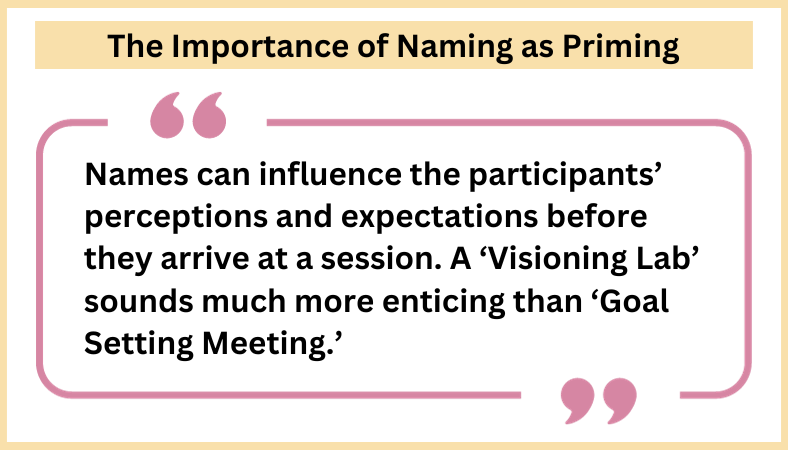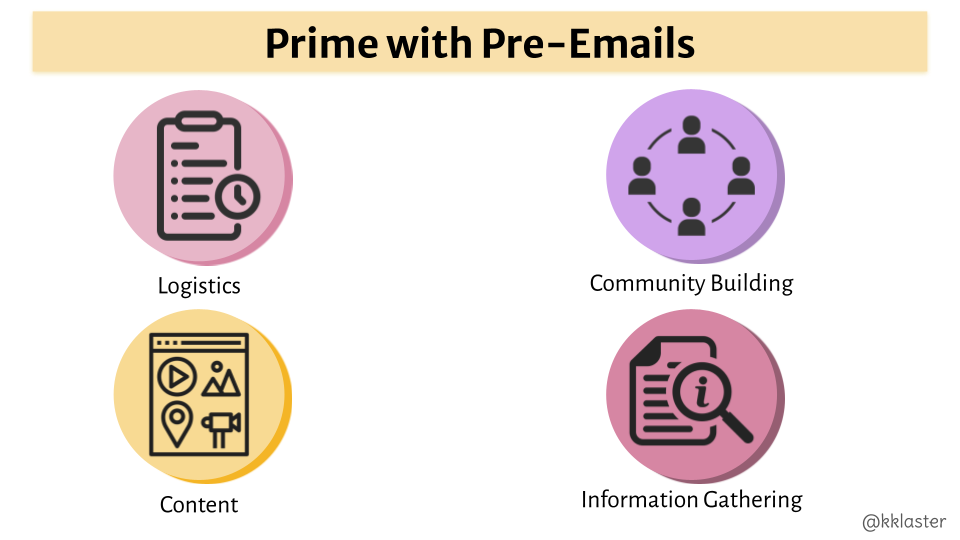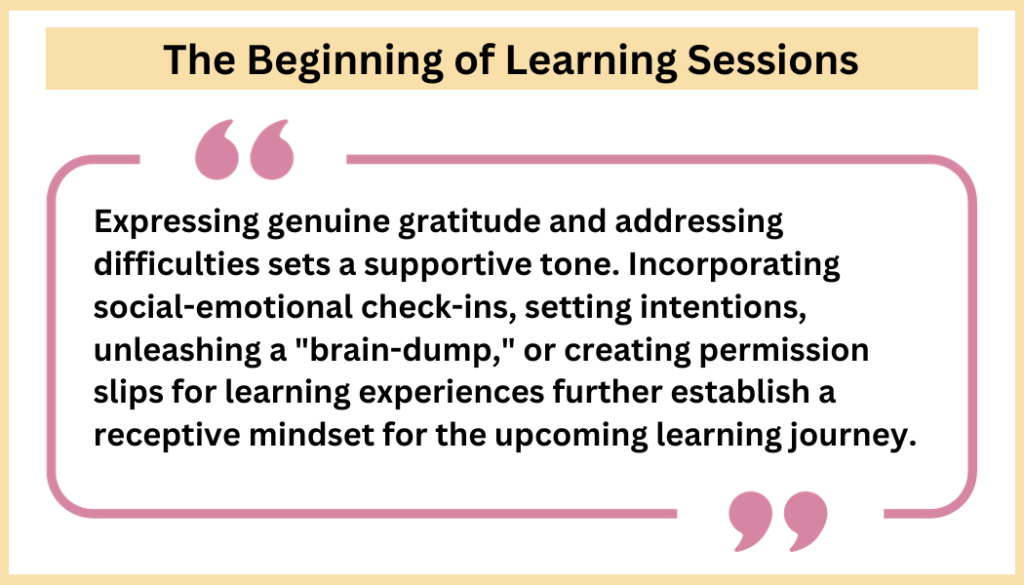If you design professional learning experiences, have you ever wished you had more time with participants? As an educator who designs PD, I often wonder, “How might I extend today’s learning beyond seat time?” Furthermore, with so many opportunities for blended learning, another question that arises is “What’s the best use of our synchronous time?”
These are some of the challenges that the concept of priming can help us address. Even if you’re not familiar with the term, chances are you’ve been using priming techniques in your sessions without realizing it.
What Is Priming?
In her book “The Art of Gathering,” Priya Parker introduces the concept of priming, which has become an integral part of how I design professional development (PD) sessions, online courses, events, and even meetings.
Cognitive priming prepares the brain for learning. When we experience something, it can affect how we respond to similar things in the future. Priming, or, the priming effect, occurs when an individual’s exposure to a certain cue influences their response to a subsequent prompt. This means that if we are exposed to something before a learning experience, or before an activity, it can influence how we perceive and respond to the new information.
Throughout this article, I’ll use the term “priming” in a broad sense, even though various types of priming—like conceptual, perceptual, expectancy, and strategy priming—exist. Let’s look at three ways we can prime adult learners to boost the benefits and effectiveness of professional learning.
Craft an Enticing Session Name
In “The Art of Gathering,” Parker states that an event begins at “the moment of discovery,” and that idea inspires me to reimagine how I title my PD sessions. Parker shares the importance of naming as priming because names can influence the participants’ perceptions and expectations before they arrive at a session. A “Visioning Lab” sounds much more enticing than “Goal Setting Meeting.” For example, I now facilitate professional book clubs, rather than book studies. As soon as potential attendees discover the name of my course, session, or workshop, that session title can help prime them for what’s to come.

Prime with a Pre-Email
Another practice that helps prime participants for learning is to be very intentional about crafting pre-emails. These pre-session emails serve a dual purpose: they streamline session time for content while building opportunities for connection and easing participants’ cognitive load with essential venue and agenda details.
Depending on the session length and format, whether a one-hour webinar or a three-hour in-person workshop, I send pre-emails one to three days prior to the event. The emails contain information categorized as:
- logistics: schedule, location, technology guidance, agenda clarification, and target audience;
- community building: a welcome from the presenter (video or text) and avenues for participants to connect (collaborative slides, Flip, Twitter hashtag);
- content: assigned videos or readings, reflective exercises on teaching practices, bringing a lesson or assessment, and linking content to standards;
- information gathering: assessing needs and readiness, fostering inclusivity by collecting information like name pronunciation, pronouns, and a favorite song.

As Elena Aguilar and Lori Cohen share in “The PD Book: 7 Habits That Transform Professional Development: “Pre‐work primes participants for what they’re about to learn—and hopefully builds excitement for the PD they are about to experience.”
Considering educators’ demanding schedules, I ensure that pre-work tasks remain manageable, often involving small activities like contributing to a Jamboard, app downloads, or watching brief (<5 minutes) videos. Furthermore, I keep these pre-emails concise, utilizing formatting and emojis to emphasize crucial details. By including a visual “invitation” similar to my session’s slide deck template and colors, I establish familiarity, priming participants to engage with my session materials.
Priya Parker’s insight – “the less priming you do in this pregame window, the more work awaits you during the gathering itself” – resonates with me. Through well-crafted pre-emails, I tackle essential logistics in advance, freeing up valuable session time for connecting and delivering content synchronously. Additionally, the “pregame window” offered by pre-emails allows participants to mentally delve into the content, building anticipation for our upcoming work.
Set the Tone for Learning Activities
Because of the priming effect, I’m now even more intentional about how I begin all professional learning sessions. I consider what’s on the screens when participants enter the Zoom room or workshop space. What do participants see, hear, and feel? In the book, “Stop Talking, Start Influencing: 12 Insights From Brain Science to Make Your Message Stick,” Dr. Jared Cooney Horvath shares that recent associations (i.e. what happens right before the PD session begins) impact how people take in and remember new information.
Acknowledging the burdens participants bring, be it work stressors or personal challenges, I counteract these “recent associations” by beginning PD sessions with a focus on individuals in the room. Expressing genuine gratitude and addressing difficulties set a supportive tone. Incorporating social-emotional check-ins, setting intentions, unleashing a “brain-dump,” or creating permission slips for learning experiences further establish a receptive mindset for the upcoming learning journey.

Moreover, Dr. Horvath emphasizes, “The first strategy we activate can influence how others interpret and tackle future tasks.” For my PD sessions, that means if I want participants to collaborate throughout the session, I ask them to immediately say hello in the Zoom chat or talk to their neighbor. When we’re using a digital document (hyperdoc, collaborative Slides, thought-catcher, etc.) I get the participants typing in that document ASAP. For a recent webinar, I wanted participants to unmute their mics and talk throughout the session (vs. the usual norm of muting mics), so at the beginning of the session, we broke the script and primed the attendees for conversations by asking them to all unmute at once and say hello. Thus, deliberate actions within the initial minutes of a session significantly prime participants for the subsequent experiences and activities.
Why Prime for Learning?
Every thoughtful session title, every well-crafted pre-session email, and every intentional engagement activity contribute to shaping how participants approach learning. You’re not just conveying information; you’re setting the stage for mindset shifts, fostering connections, and sparking curiosity. Embrace the concept of priming and watch as your efforts in designing professional learning reach new heights of effectiveness.

